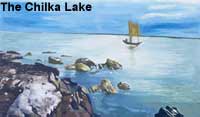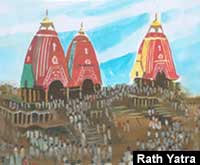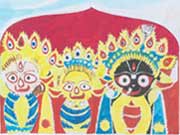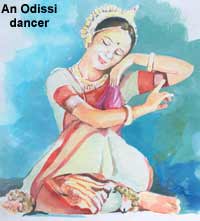
Dimdima
Online Children's Magazine from India

Dimdima
Online Children's Magazine from India

A slight deviation of a few kilometres inland, takes us to the tiny village of Bomokoi, famous for its saris. Textile weaving is a traditional handicraft of Orissa and all over the state one can see people engaged in this cottage industry. When you buy a Bomokai sari you know you have something unique because no two Bomokai saris are alike.
 Further north along the coast lies the country's biggest inland lake, the Chilka lake. A narrow inlet joins the lake to the Bay of Bengal. The lake spreads over an area of 1,100 sq. km. The water in the lake is brackish during the dry months of the year. But in the monsoons, the rivers Daya and Bhargavi flowing into the lake, drive out the salty water and fill the lake with fresh water. This is when Chilka becomes the country's largest freshwater lake.
Further north along the coast lies the country's biggest inland lake, the Chilka lake. A narrow inlet joins the lake to the Bay of Bengal. The lake spreads over an area of 1,100 sq. km. The water in the lake is brackish during the dry months of the year. But in the monsoons, the rivers Daya and Bhargavi flowing into the lake, drive out the salty water and fill the lake with fresh water. This is when Chilka becomes the country's largest freshwater lake.
The lake is dotted with tiny emerald green islands. On one small island is located the temple of Kalijai, the presiding deity of the lake. The islands are rich in aquatic fauna. In winter, colonies of ducks, cranes, pelicans and gray herons can be seen wading in the lake.
The fishing boats in Chilka have rectangular sails made of woven mat.
Our next port of call is Puri which was called Paloura in ancient times. Paloura was a famous port that carried on a flourishing maritime trade with the islands of Indonesia.
Today Paloura or Puri is a seaside resort with the longest beach in the state.It is one of the four holiest places in India for Hindus (the other three are Badri-Kedarnath, Rameswaram and Dwaraka).
The majestic temple of Jagannath, the Lord of the Universe, stands on an elevated platform in the heart of Puri. It was built in the 12th century A.D. by King Chodaganga to commemorate the shifting of his capital from south to central Orissa. Lord Jagannath is worshipped here as Lord Krishna along with his sister, Subhadra and elder brother, Balabhadra. The idols are made of wood and have an unfinished look.
According to a legend, King Indradyumna coveted the sapphire idol of Lord Vishnu that was in Puri. He decided to get it, but when he went there he found that the statue had disappeared. Ashamed of what he had come to do, he began to practise severe penance.
A voice from the heavens told him that he would find the lord's idol in the form of a log. Soon such a log appeared floating on the sea. The king had it brought ashore. He then asked his carpenters to shape the log into the image of the lord. But not a single carpenter could do so. Either their chisels broke or their hands got hurt.
Then one day, the lord appeared before the king as an old carpenter and offered to chisel an image in 21 days, provided nobody watched him at work. The king promised. but driven by curiosity, he peeped into the room before the stipulated period was over. All that the king saw in the room were three pieces of unfinished statues. The old carpenter was never seen again.
The statues are replaced with new ones every 12 years.
 The wood for making the idols, is cut only from the trunks of those neem trees seen by certain daitas or worshippers in their dreams. A certain article ( which many scholars claim to be the sacred tooth of the Buddha) is taken out from the old idol and placed in the new one by a blind-folded priest, whose hands are wrapped in cloth so that he cannot examine the contours of the object. This takes place at the Nau Kalebara festival just before the Rath Yatra, the most famous festival of the temple, which is celebrated every year in July.
The wood for making the idols, is cut only from the trunks of those neem trees seen by certain daitas or worshippers in their dreams. A certain article ( which many scholars claim to be the sacred tooth of the Buddha) is taken out from the old idol and placed in the new one by a blind-folded priest, whose hands are wrapped in cloth so that he cannot examine the contours of the object. This takes place at the Nau Kalebara festival just before the Rath Yatra, the most famous festival of the temple, which is celebrated every year in July.
 The Ratha Yatra or the Chariot Festival commemorates the journey of Lord Krishna from Gokul to Mathura. The three idols are taken out in three enormous, wooden chariots to Gundicha Bari or the Garden House of Jagannath. Nandighosa, the 16-wheeled chariot of Jagannath, is the largest of the chariots. It is 14m high and 11m wide.
The Ratha Yatra or the Chariot Festival commemorates the journey of Lord Krishna from Gokul to Mathura. The three idols are taken out in three enormous, wooden chariots to Gundicha Bari or the Garden House of Jagannath. Nandighosa, the 16-wheeled chariot of Jagannath, is the largest of the chariots. It is 14m high and 11m wide.
Although the journey is just a mile away, it takes the procession an entire day to reach Gundicha Bari. Thousands of people come to watch the spectacular event and even participate in pulling the chariot. There is a frenzy to touch the idol of Jagannath for it is believed that a single touch of the statue on this particular day can free one from the cycle of births and deaths.
The images of the gods are brought back to the main temple after 8 days in a similar ceremonious manner.
 The Odissi or Orissi dance, the classical dance of the state, traces its origin to the rituals observed in this temple. Dancers, wearing saris that are made to flow gracefully in a fanlike form from the waist to the feet, silver or white jewellery and white papier-mache flowers in their hair, pay tribute to the three idols of this temple before they begin their performance. Odissi songs are devotional. The lilting ashtapadas from Jayadeva's Git Govind, that celebrates the love of Radha and Krishna, is the favourite.
The Odissi or Orissi dance, the classical dance of the state, traces its origin to the rituals observed in this temple. Dancers, wearing saris that are made to flow gracefully in a fanlike form from the waist to the feet, silver or white jewellery and white papier-mache flowers in their hair, pay tribute to the three idols of this temple before they begin their performance. Odissi songs are devotional. The lilting ashtapadas from Jayadeva's Git Govind, that celebrates the love of Radha and Krishna, is the favourite.
Barely 16km from Puri is Raghurajpur, a village of artisans where traditional painters paint patachitras, 'paintings on cloth'.
Another 10 kilometres away is a charming Krishna temple. It has a life-size statue of Krishna as a child. Legend has it that Krishna visited this place as a child to give evidence in a dispute between two Brahmins. Hence the temple was named Sakshi Gopal (Sakshi means witness).
Last updated on :9/23/2005
Dimdima is the Sanskrit word for ‘drumbeat’. In olden days, victory in battle was heralded by the beat of drums or any important news to be conveyed to the people used to be accompanied with drumbeats.
Bharatiya Vidya Bhavan
K. M Munshi Marg,
Chowpatty, Mumbai - 400 007
email : editor@dimdima.com
Bharatiya Vidya Bhavan
505, Sane Guruji Marg,
Tardeo, Mumbai - 400 034
email : promo@dimdima.com
Dimdima.com, the Children's Website of Bharatiya Vidya Bhavan launched in 2000 and came out with a Printed version of Dimdima Magazine in 2004. At present the Printed Version have more than 35,000 subscribers from India and Abroad.